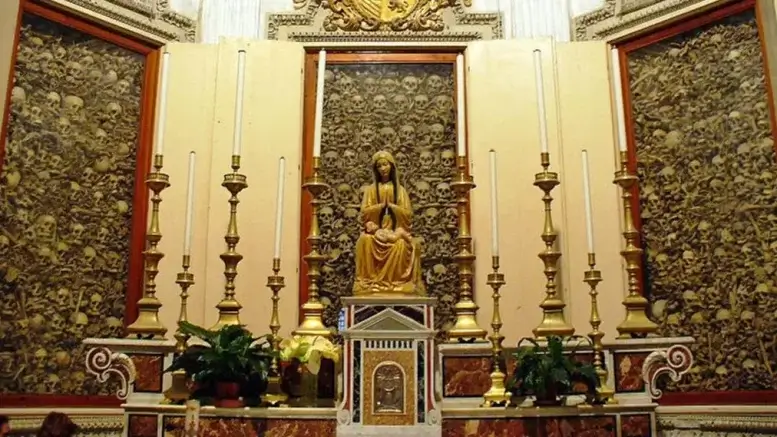Playback speed:
Last February 15, 2023 marked the eight year anniversary of when the Islamic State slaughtered 21 Christians in Libya for refusing to recant their faith. While sitting atop and holding their tied victims’ bodies down, Islamic State members shoved their fingers in the Christians’ eye sockets, craned their heads back, and sliced away at their throats with knives. Some of the Christians could be seen mouthing, “Oh, Lord Jesus Christ,” in the seconds before having their heads carved off.
Inasmuch as the 21 martyrs should be remembered and commemorated, they are ultimately modern day reflections of an ancient (and ongoing) phenomenon that permeates nearly fourteen centuries of history: Muslims slaughtering Christians who refuse to renounce Christ and embrace Muhammad.
Indeed, on this day in history, March 6, Catholic and Orthodox churches commemorate 42 other Christians who were also beheaded 1,170 years before half their number—the 21 Coptic Christians—were executed under very similar circumstances. Known as the 42 Martyrs of Amorium, their story follows:
In 838, Caliph al-Mu‘tasim—at the head of eighty thousand slave-soldiers—burst into Amorium, one of the Eastern Roman Empire’s largest and most important cities. They burned and razed it to the ground and slaughtered countless; everywhere there were “bodies heaped up in piles,” writes a chronicler. The invaders locked those who sought sanctuary inside their churches and set the buildings aflame; trapped Christians could be heard crying kyrie eleison—“Lord have mercy!” in Greek—while being roasted alive. Hysterical “women covered their children, like chickens, so as not to be separated from them, either by sword or slavery.”
About half of the city’s seventy thousand citizens were slaughtered, the rest hauled off in chains. There was such a surplus of human booty that when the caliph came across four thousand male prisoners he ordered them executed on the spot. Because there “were so many women’s convents and monasteries” in this populous Christian city, “over a thousand virgins were led into captivity, not counting those that had been slaughtered. They were given to the Moorish and Turkish slaves, so as to assuage their lust,” laments the chronicler.
When the young emperor, Theophilus (r. 829–842), heard about the sack of Amorium—his hometown, chosen by the caliph for that very reason, to make the sting hurt all the more—he fell ill and died three years later, aged 28, reportedly of sorrow. Meanwhile, the Muslim poet Abu Tammam (805‐845) celebrated the caliph’s triumph, since “You have left the fortunes of the sons of Islam in the ascendant, and the polytheists [Christians] and the abode of polytheism in decline.” (For the full story of Amorium, see Chapter 4 of Sword and Scimitar.)
Among the many captives carted off to Iraq were forty-two notables, mostly from the military and clerical classes (which in early Christianity were often closely associated). Due to their prestigious status and in order to make them trophies of Islam, they were repeatedly pressured to convert:
During the seven years of their imprisonment, their captors tried in vain to persuade them to renounce Christianity and accept Islam. The captives stubbornly resisted all their seductive offers and bravely held out against terrible threats. After many torments that failed to break the spirit of the Christian soldiers, they condemned them to death, hoping to shake the determination of the saints before executing them. The martyrs remained steadfast…
Interestingly, some of the arguments used by Muslims indicate that they acknowledged Christ as the Prince of Peace and Muhammad as the Lord of War—and played it to great effect. One Theodore, a Christian cleric who fought in defense of Amorium, was goaded as follows: “We know that you forsook the priestly office, became a soldier and shed blood [of Muslims] in battle. You can have no hope in Christ, whom you abandoned voluntarily, so accept Mohammed.” Theodore replied: “You do not speak truthfully when you say that I abandoned Christ. Moreover, I left the priesthood because of my own unworthiness. Therefore, I must shed my blood for the sake of Christ, so that He might forgive the sins that I have committed against Him.”
In the end, none would recant; and so, on March 6, 845, after seven years of torture and temptation failed to make them submit to Muhammad, all 42 Christians were—like their 21 spiritual descendants, the Coptic martyrs—also marched to a body of water, the Euphrates River, ritually beheaded, and their bodies dumped into the river.
Historical texts throughout the centuries are filled with similar anecdotes, including the “60 Martyrs of Gaza,” Christian soldiers who were executed for refusing Islam during the seventh century Islamic invasion of Jerusalem. Seven centuries later, during the Islamic invasion of Georgia, Christians refusing to convert were forced into their church and set on fire.
Closer to home, in 1480, the Turks invaded Italy and sacked the city of Otranto. More than half of its 22,000 inhabitants were massacred, 5,000 hauled off in chains. To demonstrate his magnanimity, Sultan Muhammad II offered freedom to 800 chained Christian captives, on condition that they all embrace Islam. Instead, they unanimously chose to act on the words of one of their numbers: “My brothers, we have fought to save our city; now it is time to battle for our souls!”
Outraged that his invitation was spurned, on August 14 on a hilltop (subsequently named “Martyr’s Hill”), Muhammad ordered the ritual decapitation of these 800 unfortunates; their archbishop was slowly sawed in half to jeers and triumphant cries of “Allah Akbar!” (The skeletal remains of some of these defiant Christians were preserved and can still be seen in the Cathedral of Otranto.)
Whoever still fails to see a pattern in the martyrdom of Christians at the hands of Muslims might consider consulting the book, Witnesses for Christ: it lists 200 anecdotes of Christians killed—including some burned at the stake, thrown on iron spikes, dismembered, stoned, stabbed, shot at, drowned, pummeled to death, impaled and crucified—for refusing to embrace Islam during the Ottoman era alone.





